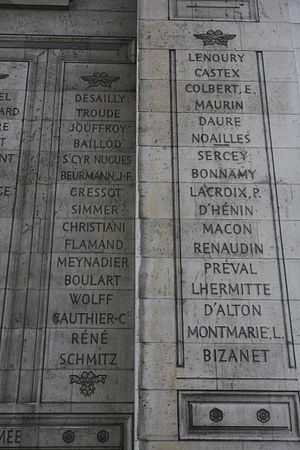Antoine Maurin
| Antoine Maurin | |
|---|---|
|
Maurin is the fourth name on Column 40 | |
| Born |
December 19, 1771 Montpellier, France |
| Died | October 4, 1830 (aged 58) |
| Allegiance |
|
| Service/branch | Cavalry |
| Years of service | 1792–1823 |
| Rank | General of Division |
| Battles/wars |
Battle of Biberach (1796) Battle of Valvasone (1797) Battle of Caldiero (1805) Battle of Guttstadt-Deppen (1807) Battle of Friedland (1807) Invasion of Portugal (1807) Battle of Dresden (1813) Battle of Leipzig (1813) Battle of Laubressel (1814) Battle of Ligny (1815) |
| Awards | Légion d'Honneur, CC 1813 |
| Other work | Baron of the Empire, 1808 |
Antoine Maurin (19 December 1771 – 4 October 1830) commanded a French cavalry division in 1814 during the Napoleonic Wars and in 1815 led his troops against the Prussians at Ligny where he was wounded. His army service began in 1792 during the French Revolution when he enlisted in a cavalry regiment as a trooper. He spent his entire military career as a cavalryman. During the French Revolutionary Wars he advanced through the ranks and became commander of a light cavalry regiment in 1802. While only a colonel, he commanded a brigade at Caldiero in October 1805. He fought in the Friedland campaign in 1807 and attained the rank of general officer that year. As a cavalry brigadier, he participated in the 1807 Invasion of Portugal but was captured in 1808 and held until 1812. He led a brigade in 1813 and a division 1814 during the War of the Sixth Coalition. After fighting for Napoleon during the Hundred Days, he retired in 1823. His surname is one of the names inscribed under the Arc de Triomphe.
Career
Maurin was born in Montpellier, France on 19 December 1771. He joined the 20th Chasseurs à Cheval Regiment as a trooper in 1792. He served in a number of actions during the War of the First Coalition rising to the rank of officer. He was wounded in the shoulder by a saber cut at Biberach in 1796. The following year he fought at Valvasone and received a battlefield promotion to captain from Napoleon Bonaparte.[1]
On 24 April 1802 he was named to lead the 24th Chasseur à Cheval Regiment as Chef de Brigade (colonel).[2] While still a colonel, he led a brigade consisting of the 15th and 24th Chasseurs à Cheval at the Battle of Caldiero on 29–31 October 1805.[3] Transferred to Poland, he fought at Guttstadt and Friedland in 1807 and was promoted to general of brigade in late June 1807.[1]
Maurin led a cavalry brigade in Andoche Junot's army during the 1807 Invasion of Portugal.[4] He was named Baron of the Empire on 17 March 1808.[2] He reported to François Étienne de Kellermann who commanded a cavalry division that included one squadron each of the 26th Chasseurs à Cheval, 1st, 3rd, 4th, 5th, 9th, and 15th Dragoons.[4] He was appointed governor of Algarve province in the south of Portugal. When the revolt against the French occupation broke out, he was in his sickbed in Faro. He and 70 other French soldiers were captured by Portuguese partisans on 16 June 1808 and handed over to the captain of a British vessel as prisoners.[5] He remained a prisoner until September 1812. On his return he fought at the Battle of Dresden on 26–27 August 1813.[1] He received the Commander's Cross of the Légion d'Honneur on 28 September 1813.[2] Maurin commanded the 9th Light Cavalry Brigade in Rémi Joseph Isidore Exelmans' division of the II Cavalry Corps at the Battle of Leipzig on 16–19 October.[6]
The following year he was named to command the 2nd Light Cavalry Division and led this unit at the Battle of Laubressel on 3–4 March 1814.[7] After Napoleon's abdication he submitted to King Louis XVIII of France.[1] He later rejoined the emperor during the Hundred Days and was appointed to command the 7th Cavalry Division in the 1815 campaign. The division's 1st Brigade was led by Louis Vallin and consisted of the 6th Hussars and 8th Chasseurs à Cheval Regiments. The 2nd Brigade was under Pierre Marie Auguste Berruyer and comprised the 6th, 11th, and 18th Dragoon Regiments.[8] At the Battle of Ligny on 16 June 1815, he was wounded in the chest by a bullet. Maurin retired in 1823. After the July Revolution of 1830 he returned to active service but died on 4 October 1830. His surname is one of the names inscribed under the Arc de Triomphe, on the west pillar on Column 40.[1]
Notes
References
- Broughton, Tony (2000). "French Chasseur-a-Cheval Regiments and the Colonels who Led Them: 1791-1815, 21st to 31st". The Napoleon Series. Retrieved 16 September 2012.
- Haythornthwaite, Philip J. (1974). Uniforms of Waterloo. New York, NY: Hippocrene Books. ISBN 0-88254-283-4.
- Mullié, Charles (1852). Biographie des célébrités militaires des armées de terre et de mer de 1789 a 1850 (in French). Paris.
- Oman, Charles (2010). A History of the Peninsular War Volume I. La Vergne, Tenn.: Kessinger Publishing. ISBN 1432636820.
- Schneid, Frederick C. (2002). Napoleon's Italian Campaigns: 1805-1815. Westport, Conn.: Praeger Publishers. ISBN 0-275-96875-8.
- Smith, Digby (1998). The Napoleonic Wars Data Book. London: Greenhill. ISBN 1-85367-276-9.
